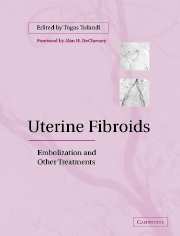Book contents
- Frontmatter
- Contents
- Contributors
- Preface
- Foreword
- 1 Uterine fibroids: epidemiology and an overview
- 2 Histopathology of uterine leiomyomas
- 3 Imaging of uterine leiomyomas
- 4 Abdominal myomectomy
- 5 Laparoscopic managment of uterine myoma
- 6 Hysteroscopic myomectomy
- 7 Myomas in pregnancy
- 8 Expectant and medical management of uterine fibroids
- 9 Hysterectomy for uterine fibroid
- 10 History of embolization of uterine myoma
- 11 Uterine artery embolization – vascular anatomic considerations and procedure techniques
- 12 Pain management during and after uterine artery embolization
- 13 Patient selection, indications and contraindications
- 14 Results of uterine artery embolization
- 15 Side effects and complications of embolization
- 16 Reproductive function after uterine artery embolization
- 17 Reasons and prevention of embolization failure
- 18 Future of embolization and other therapies from gynecologic perspectives
- 19 The future of fibroid embolotherapy: a radiological perspective
- Index
- Plate section
9 - Hysterectomy for uterine fibroid
Published online by Cambridge University Press: 10 November 2010
- Frontmatter
- Contents
- Contributors
- Preface
- Foreword
- 1 Uterine fibroids: epidemiology and an overview
- 2 Histopathology of uterine leiomyomas
- 3 Imaging of uterine leiomyomas
- 4 Abdominal myomectomy
- 5 Laparoscopic managment of uterine myoma
- 6 Hysteroscopic myomectomy
- 7 Myomas in pregnancy
- 8 Expectant and medical management of uterine fibroids
- 9 Hysterectomy for uterine fibroid
- 10 History of embolization of uterine myoma
- 11 Uterine artery embolization – vascular anatomic considerations and procedure techniques
- 12 Pain management during and after uterine artery embolization
- 13 Patient selection, indications and contraindications
- 14 Results of uterine artery embolization
- 15 Side effects and complications of embolization
- 16 Reproductive function after uterine artery embolization
- 17 Reasons and prevention of embolization failure
- 18 Future of embolization and other therapies from gynecologic perspectives
- 19 The future of fibroid embolotherapy: a radiological perspective
- Index
- Plate section
Summary
The most common indication for hysterectomy is uterine fibroids. It is estimated that approximately one-third of all hysterectomies are done for problems related to uterine fibroids. The clinical indications vary from merely the presence of fibroid to menorrhagia, pressure symptoms, infertility, or habitual abortion.
In many instances they are asymptomatic, but in some women they may be associated with heavy menstrual bleeding, infertility, pressure symptoms, and miscarriage. Hysterectomy can be performed abdominally, laparoscopically, or vaginally, and could be total or subtotal. The approach of the procedure is determined by the clinical situation, the preference and the expertise of the surgeon, and to a certain extent by the patient's desire. In this review we will discuss the risks and benefits of different types of hysterectomy in the treatment of uterine fibroid.
Abdominal hysterectomy
Total abdominal hysterectomy (TAH) remains the conventional treatment for uterine fibroids in women who have completed their family. In the United States, 75% of all hysterectomies are done by laparotomy, which is threefold higher than that for vaginal hysterectomy (VH). TAH is a major operation with three to five days of hospitalization and a convalescence time of several weeks. It is associated with major morbidity in 3% and minor morbidity in about 14% of cases. However, it is a well-received operation with as many as 85–90% of women being satisfied with the procedure and reporting improved quality of life.
- Type
- Chapter
- Information
- Uterine FibroidsEmbolization and other Treatments, pp. 74 - 79Publisher: Cambridge University PressPrint publication year: 2003



